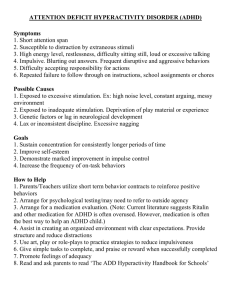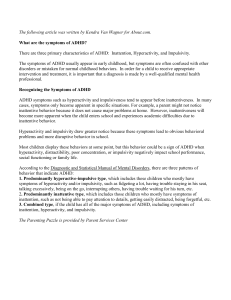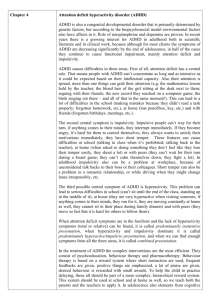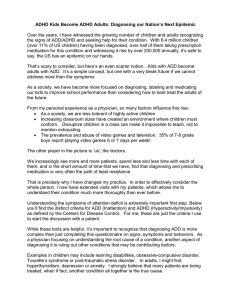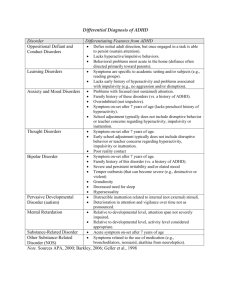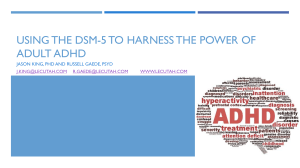Help! How Do I Manage These Strong
advertisement
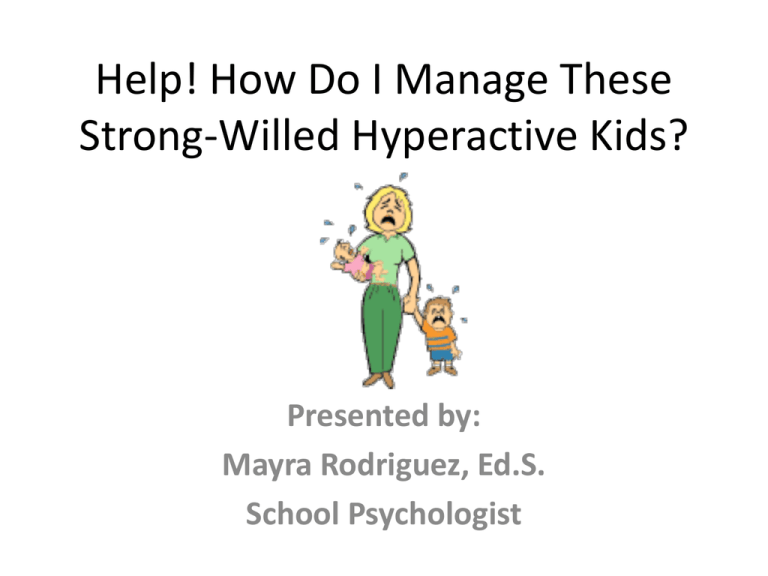
Help! How Do I Manage These Strong-Willed Hyperactive Kids? Presented by: Mayra Rodriguez, Ed.S. School Psychologist ATTENTION DEFICIT DISORDERS • Teachers, child care workers, and school personnel are key to diagnosis and successful outcomes INTRODUCTION ACTIVITY Identify a current student you suspect might have A.D.H.D. Many Names for A.D.H.D. Early 1900’s....Minimal Brain Damage Early 1900’s....Minimal Brain Dysfunction Mid 1900’s....Hyperkinetic Reaction of Childhood Early 1980’s....Attention Deficit Disorder w/wo Hyperactivity Late 1980’s.....Attention-Deficit Hyperactivity Disorder Present............Attention-Deficit / Hyperactivity Disorder (Type I, Type II, or Combined) A.D.H.D. STATISTICS • Occurs in 3-5% of school-age children – All socioeconomic, cultural, and racial backgrounds – All intelligence levels • More prevalent in males – 4:1 male to female ratio in general population – 9:1 male to female ratio in clinical population A.D.H.D. STATISTICS • Symptoms identified in up to 80% of adolescents with A.D.H.D. – Problems continue after childhood in 66% of cases • Hereditary link suggested Is ADHD Over-Diagnosed? Is ADHD Over-Diagnosed? • FACT – 3.5 million children meet criteria for ADHD; only 50% are diagnosed and treated • FACT – 57% of children with ADHD receive accurate diagnosis • FACT – Only 20% of black children with ADHD are diagnosed • FACT – Overall parental knowledge about ADHD among African-American parents may play an important role in delaying diagnosis The Societal Burden of Not Treating ADHD • 30% of children in special education • 30% repeat a grade • 25% of adolescents expelled from school • 35% of students drop out of school • 26% arrested • 55% untreated grow up to be substance abusers • Engage in other high risk behaviors, more partners Children With A.D.H.D. Exhibit Age-Inappropriate Behavior Patterns • Inattention • Impulsivity • Hyperactivity A.D.H.D. Interferes with School Success Inattention Symptoms: Child experiences difficulty in…. • Starting, staying with, and completing tasks that require sustained attention • Making careless mistakes • Making transitions • Following directions / listening • Performing consistently • Organizing tasks • Losing things / forgetfulness Impulsivity Symptoms • • • • Low frustration tolerance Difficulty waiting turn Interrupts others & ignores boundaries Blurting out answers before question is completed • Difficulty anticipating outcomes • Often irritable/ impatient; but otherwise quite charming Impulsivity Symptoms • Cannot keep hands to themselves • Often appear reckless, clumsy, or accident-prone • Often provoke conflict just for the love of excitement!!!! • Can easily produce chaos in class or turn home into a battleground Hyperactivity Symptoms • Fidgeting • Rarely seated, or squirms in seat • Moving excessively • Difficulty playing or working quietly • Always “on the go” • Excessive talking • Varies with age & developmental level • Often makes noise during quiet activities • Up often during meals Symptoms often disappear when the child is with another person who is closely scrutinizing him, when confronted with an interesting task, or a novel situation DSM-V DIAGNOSTIC TERMS Attention-Deficit / Hyperactivity Disorder • Inattentive Type • Hyperactive-Impulsive Type • Combined Type Persistence, Pattern, and Frequency of Symptoms • A persistent pattern… more frequent & severe than developmentally appropriate • First appeared before age 7 • Persist for 6 months or more • Present in at least 2 settings • Interference with social or academic functioning Symptoms Change Over the Years • • • • • • Elementary School Fidgety Excessive talking Erratic performance Bossy Constant demand for attention Easily loses control • • • • • • Adolescence Restlessness Talks out of turn Problems at school Problems with peers Poor judgment Difficulty getting independence from parents DIAGNOSTIC PROCESS TIER 1: Presence of Symptoms • Interview parents and teachers • Obtain developmental history • Review school and medical records • Complete behavioral rating scales • Observe during an auditory vigilance task. • Interview student / self-report DIAGNOSTIC PROCESS TIER 2: Degree of Impact on Functioning • Classroom observation • Psychoeducational tests Intervention Strategies Should Target... • Classroom behavior • Academic performance • Social interactions Strategies That Enhance Productivity and Behavior Classroom Management Strategies • Schedule academic skills subjects in AM • Provide regular and frequent breaks • Agree on “secret signal” for student • Develop “time-to-begin” cues Classroom Management Strategies • Teach self-monitoring techniques • Devise & practice attention-getting strategies • Divide assignments and present in smaller segments • Use behavioral reinforcement system Organization Strategies • Orderly, predictable, structured, consistent environment • Minimal distractions, quiet work area, background noise (white noise) • Prominent display of rules, schedules, and assignments • Advanced warning before transition of activity Curriculum Accommodations • Reduced homework / classwork • Increased time for completing assignments and tests • Mixture of high- and low-interest activities (task novelty) • Curriculum integration • Seek meaning/ purpose Curriculum Accommodations • Use of computers for written assignments • Teach/ prompt organization and study skills • Interactive instruction vs. lecture • Visual references for oral instructions • Avoid timed tests Social Skills Strategies/ Impulse Control • • • • Social skills training Conflict resolution training Anger management therapy Compliance training Family Issues • Parent training to learn how to parent an ADHD child • Parent training to reinforce social skills training • Family therapy to heal damaged relationship issues What About Psychostimulant Medication? What About Psychostimulant Medication? • 70-75% of children with A.D.H.D. improve • Degree of response may vary • Effective dosage may vary Medication is sometimes useful in helping ADHD children…. • become less irritable & restless • improve attention & motor coordination • become less impulsive, therefor, better liked by others • improve in pro-social & appropriate school behavior What About Psychostimulant Medication? • Effective with adolescents and adults, although the extent of improvement is smaller than with younger children • Medication is only one part of a total management program Successful Management of A.D.H.D. Takes a Team Effort AND…a great deal of prayer! Let your ADHD student know you love them & care about them regardless of how they behave!
